Winniconic River
The Winniconic River (/ˌwɪ nɪ ˈkä nik/) is a tributary of the Piscataqua River in Strafford County, New Hampshire. Rising in Barrington, at the outlet of Swains Pond, it flows generally east, passing through the Winniconic Reservoir and the village of Center Madbury, before turning to the southeast and pouring over a series of falls into Little Bay, which connects Great Bay with the Piscataqua River and the Atlantic Ocean.
At just over fifteen miles long, the Winniconic drains approximately 26.4 square miles. It is part of coastal New Hampshire’s Piscataqua River watershed, which also includes the Cocheco River, the Salmon Falls River, the Oyster River and Great Bay. With the exception of the Center Madbury village area, there is relatively little development along most of the river’s forested and rural course. However, increasing development along nearby state roads 16 and 108 has been seen in recent years.
Passing over the dam, the river courses through the village of Center Madbury. It is crossed there by an iron bridge, built in 1934, which carries Bridge Street south from the village center to its connections with Demeritt Road, Coffin Road, and Durham Road on the right bank. Just to the east, a wooden trestle brings the Boston & Maine Railroad line into the Madbury station from Exeter and Durham.
Beyond the village, and following a brief stretch of rapids, the river takes a sharp turn to the right at Upper Falls, the site of the first sawmill in Madbury. Below the short Upper Falls, the river slows briefly, forming a popular swimming hole known locally as “Sawmill Lake.” It then makes its way around Garrison Hill rising steeply on its right bank, before plunging into Silver Falls Gorge.
After leaving the gorge, the Winniconic widens a bit, moving swiftly until it reaches the steep rapids known as Lower Falls, which separate the freshwater and saltwater portions of the river, just north of the Water Street bridge. Below the small wooden bridge, the river assumes its tidal nature, with broad mud flats on either side, and sometimes reverting to a slow trickle at the ebb of its approximately five foot tidal range.
European settlement began in the 1630s. The first mill was built on the Winniconic by Capt. Peter Coffin and two partners in 1651. The Coffin Lumber Co., Inc., still in operation today, is the second oldest continuously operating business concern in New Hampshire, the oldest being Tuttle’s Farm in Dover, founded in 1632. The ruined foundations of the original Coffin sawmill are still visible alongside the river to this day.
The Winniconic Reservoir, which provides drinking water for the cities of Dover and Portsmouth, was formed by the construction of the Winniconic River Dam by the U.S. Army Corps of Engineers in 1959. The reservoir is also fed by Bellamy Brook to the north.
Eighteen fish species are known to live in the exceptionally pure waters of the river, including the endangered brook lamprey and the globally threatened bridle shiner, as well as abundant game fish such as brook trout, largemouth bass, yellow perch and black crappie, all of which breed in the calm waters of Swains Pond. In addition, the state Department of Fish and Game restocks the river’s supply of trout annually. Many of the fish species in the lower part of the river are diadromous, moving easily between fresh and salt water.
One hundred thirty-nine plant species have been identified along the banks of the Winniconic, which is one of the more vegetation-diverse rivers in New Hampshire. Its dominant ecosystems are dry coastal forest and moist coastal forest. Several endangered plant species can be found along the banks of the Winniconic, including wild lupine, little-headed spike sedge, smooth black sedge, clustered sedge, Canada shore quillwort and button sedge.
At just over fifteen miles long, the Winniconic drains approximately 26.4 square miles. It is part of coastal New Hampshire’s Piscataqua River watershed, which also includes the Cocheco River, the Salmon Falls River, the Oyster River and Great Bay. With the exception of the Center Madbury village area, there is relatively little development along most of the river’s forested and rural course. However, increasing development along nearby state roads 16 and 108 has been seen in recent years.
Etymology
The name Winniconic is derived from the Abenaki winni (waters) + t’kot’nauk (steep), hence meaning “steep waters,” perhaps a reference to the falls at the lower end of the river.Geography
The Winniconic River runs east out of Swains Pond in Barrington just west of Hall Road, and travels as a small forested river for about four miles before entering Madbury, where it continues through the woods to the south of Moharimet Hill before flowing into the Winniconic Reservoir.Passing over the dam, the river courses through the village of Center Madbury. It is crossed there by an iron bridge, built in 1934, which carries Bridge Street south from the village center to its connections with Demeritt Road, Coffin Road, and Durham Road on the right bank. Just to the east, a wooden trestle brings the Boston & Maine Railroad line into the Madbury station from Exeter and Durham.
Beyond the village, and following a brief stretch of rapids, the river takes a sharp turn to the right at Upper Falls, the site of the first sawmill in Madbury. Below the short Upper Falls, the river slows briefly, forming a popular swimming hole known locally as “Sawmill Lake.” It then makes its way around Garrison Hill rising steeply on its right bank, before plunging into Silver Falls Gorge.
After leaving the gorge, the Winniconic widens a bit, moving swiftly until it reaches the steep rapids known as Lower Falls, which separate the freshwater and saltwater portions of the river, just north of the Water Street bridge. Below the small wooden bridge, the river assumes its tidal nature, with broad mud flats on either side, and sometimes reverting to a slow trickle at the ebb of its approximately five foot tidal range.
History
The Winniconic River corridor has a long history of human occupation. The aboriginal populations first encountered by European explorers are believed to have inhabited the area for 3,000 to 5,000 years, although there is some archaeological evidence of human populations dating back as far as 11,000 years ago. The river was widely used by native populations for fishing and shellfish collection.European settlement began in the 1630s. The first mill was built on the Winniconic by Capt. Peter Coffin and two partners in 1651. The Coffin Lumber Co., Inc., still in operation today, is the second oldest continuously operating business concern in New Hampshire, the oldest being Tuttle’s Farm in Dover, founded in 1632. The ruined foundations of the original Coffin sawmill are still visible alongside the river to this day.
The Winniconic Reservoir, which provides drinking water for the cities of Dover and Portsmouth, was formed by the construction of the Winniconic River Dam by the U.S. Army Corps of Engineers in 1959. The reservoir is also fed by Bellamy Brook to the north.
Geology
The Winniconic River was formed approximately 18,000 years ago as the last glaciers of the Ice Age moved over New England, shaping the landscape, and influencing the characteristics of its watershed area. As a result, the bedrock underlying the river is covered by stratified-drift deposits, making the banks very fertile and suitable for farming. The Winniconic is also home to an array of plutonic and meta-sedimentary rock formations. The porous rock adjoining and underlying the river has given rise to a proliferation of aquifers and natural springs in the area.Wildlife & Vegetation
The Winniconic River corridor contains several areas of critical high-quality wildlife habitat. A wide variety of wildlife species rely upon the river and its forested banks to provide safe passage from the coast to inland wooded areas, including moose, otters, fishers, beavers, muskrats, deer and several varieties of turtle. In addition, over 100 bird species have been identified along its course, including endangered species such as osprey and upland sandpipers.Eighteen fish species are known to live in the exceptionally pure waters of the river, including the endangered brook lamprey and the globally threatened bridle shiner, as well as abundant game fish such as brook trout, largemouth bass, yellow perch and black crappie, all of which breed in the calm waters of Swains Pond. In addition, the state Department of Fish and Game restocks the river’s supply of trout annually. Many of the fish species in the lower part of the river are diadromous, moving easily between fresh and salt water.
One hundred thirty-nine plant species have been identified along the banks of the Winniconic, which is one of the more vegetation-diverse rivers in New Hampshire. Its dominant ecosystems are dry coastal forest and moist coastal forest. Several endangered plant species can be found along the banks of the Winniconic, including wild lupine, little-headed spike sedge, smooth black sedge, clustered sedge, Canada shore quillwort and button sedge.
Recreation
The Winniconic River offers numerous recreational opportunities along is course. These include hiking, nature study, picnicking, swimming and fishing. Public access for fishing, canoeing and kayaking can be found at several locations in Barrington and Madbury. Motorized boats are prohibited, and are also quite impractical in light of the river’s shallowness and rocky bottom. Several trails facilitate hiking along the entire length of the river. Many locations provide excellent vantage points for birdwatching or observing the local wildlife.Winniconic River
WATERWAY
LOCATION
Country
United States
Region
New England
State
New Hampshire
County
Strafford
Towns/Cities
Barrington, Madbury, Dover





Comments